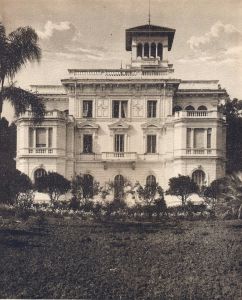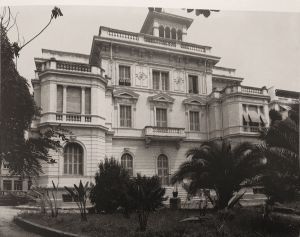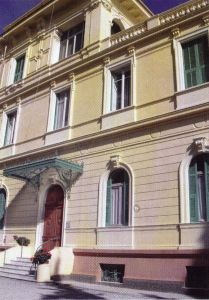There was a problem loading image 'images/ville/26_villa_rothenburg_4_la_villa_vista_dall_alto'
There was a problem loading image 'images/ville/26_villa_rothenburg_4_la_villa_vista_dall_alto'
A villa that changed its name

 It was rented in 1876-77 to his aide-de-camp, Marquis Dragonetti, by the Duke of Aosta Amedeo di Savoia, who used to spend the winter seasons, together with his wife, in Villa Dufour, the present Villa Magnolie.
It was rented in 1876-77 to his aide-de-camp, Marquis Dragonetti, by the Duke of Aosta Amedeo di Savoia, who used to spend the winter seasons, together with his wife, in Villa Dufour, the present Villa Magnolie.
 Later bought by the German princess Beatrice di Rothemburg, the villa was transformed into its present form in 1902 according to a design by the engineer Pietro Agosti, who enlarged it considerably and restructured it on the basis of neo-Renaissance inspired models, which closely echoed those already used by Pio Soli in the Villa Bel Respiro.
Later bought by the German princess Beatrice di Rothemburg, the villa was transformed into its present form in 1902 according to a design by the engineer Pietro Agosti, who enlarged it considerably and restructured it on the basis of neo-Renaissance inspired models, which closely echoed those already used by Pio Soli in the Villa Bel Respiro.
At the end of the First World War the nuns of the Giovanna d'Arco College acquired the building from the Italian government and at the same time changed its name to Villa Jeanne d'Arc (Joan of Arc).
The interior decorations, including a series of fine frescoes in typical Art Nouveau style dating back to the early twentieth century, are still well preserved in the atrium, along the internal staircase and in the halls of the villa, currently used as offices, meeting place and home of the Bishop of the Diocese of Ventimiglia-Sanremo, to which the building belongs.
 Finally, we would like to point out the large park surrounding the villa created by the famous German architect Lodovico Winter, already known on the Riviera for having designed the Hanbury Gardens at La Mortola and who also designed the park of Villa Zirio and that of the Devachan Castle, which was then drastically reduced.
Finally, we would like to point out the large park surrounding the villa created by the famous German architect Lodovico Winter, already known on the Riviera for having designed the Hanbury Gardens at La Mortola and who also designed the park of Villa Zirio and that of the Devachan Castle, which was then drastically reduced.
Villa Giovanna d'Arco was bought in the early 70s by the bishop of the time Mons. Angelo Raimondo Verardo, a part of the villa was rented to the Red Cross until the beginning of 2000 and then important works were done on the modern structure behind the historic building.
After the works the seat of the diocesan curia was transferred from Ventimiglia to Sanremo. Currently the historical villa is used for meetings and as a representative office of the bishop, and the bishop lives in a small flat.
(source: re-elaboration from a text by Andrea Gandolfo, updates by Ernesto Porri; images: our archive)




